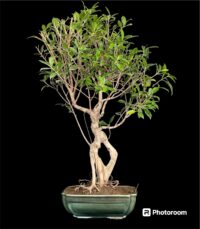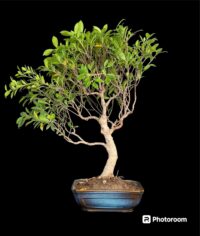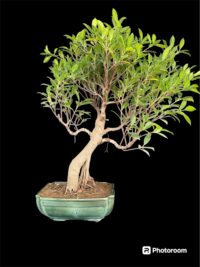Bonsai care in monsoon season near Delhi
A guide on Bonsai care in monsoon season near Delhi by Bonsai masters.
During the monsoon season near Delhi, bonsai care requires some adjustments to ensure the well-being of your miniature trees. Here are some important considerations for taking care of bonsai during the monsoon.
Benefits of rains for Bonsais:-
Rains can provide several benefits to bonsai trees. Here are some advantages of rainfall for bonsai:
Adequate Water Supply: Rainwater is a natural and beneficial source of hydration for bonsai trees. It provides a consistent and evenly distributed water supply to the roots, helping to maintain proper moisture levels in the soil.
Natural Nutrient Boost: Rainwater contains small amounts of dissolved nutrients, which can act as a natural fertilizer for bonsai trees. When it rains, these nutrients are absorbed by the soil and taken up by the tree’s roots, contributing to its overall nutrition.
Hydration and Growth: Sufficient moisture from rainfall helps keep bonsai trees well-hydrated, supporting their growth and development. Proper hydration ensures that the tree’s foliage remains lush and healthy, promoting vibrant and attractive foliage.
Washing Away Dust and Debris: Rainfall washes away dust, dirt, and other debris that may accumulate on the bonsai tree’s leaves and branches. This cleansing effect helps keep the foliage clean, allowing for better light absorption and reducing the risk of pests and diseases.
Improved Air Quality: Rainfall has a purifying effect on the air by reducing the concentration of airborne pollutants, dust, and allergens. Cleaner air quality benefits bonsai trees by minimizing stress and promoting their overall well-being.
Enhanced Root Oxygenation: Rainwater helps oxygenate the soil by displacing trapped air pockets. This improved oxygenation benefits the bonsai’s root system, as oxygen is essential for healthy root growth and nutrient uptake.
Environmental Humidity: Rainfall increases the ambient humidity in the surrounding environment. Bonsai trees, especially those that thrive in higher humidity, can benefit from this increased moisture content, supporting their overall health and foliage quality.
Stress Relief: During hot and dry periods, rainfall provides relief to bonsai trees by alleviating heat stress. The cooling effect of rainwater can help prevent the bonsai from experiencing excessive water loss through transpiration, reducing the risk of dehydration and wilting.
While rains offer numerous benefits, it’s important to maintain a balance. Excessive rainfall can lead to waterlogging, root rot, and other related problems. Proper drainage, monitoring moisture levels, and adjusting watering practices are essential to ensure the bonsai’s well-being during the rainy season.
Monsoon: Ideal Time for Bonsai Training and Maintenance
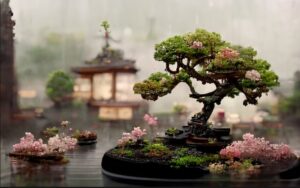 The monsoon season presents a favourable opportunity for bonsai enthusiasts to engage in training and shaping their miniature trees. This period marks a significant growth spurt, and the results of your efforts can be witnessed sooner. Among the various techniques, wiring plays a crucial role in bonsai styling and training. While wiring can be performed throughout the year, the monsoon season proves to be particularly advantageous. The accelerated growth rate of bonsai during this time ensures speedy and steady results, making it an ideal period for wiring.
The monsoon season presents a favourable opportunity for bonsai enthusiasts to engage in training and shaping their miniature trees. This period marks a significant growth spurt, and the results of your efforts can be witnessed sooner. Among the various techniques, wiring plays a crucial role in bonsai styling and training. While wiring can be performed throughout the year, the monsoon season proves to be particularly advantageous. The accelerated growth rate of bonsai during this time ensures speedy and steady results, making it an ideal period for wiring.
In addition to wiring, pruning stands as one of the most effective techniques in maintaining the desired style of a bonsai. Once again, the monsoon season offers the most suitable conditions for carrying out this activity. With active growth and ample moisture, the tree responds well to pruning, aiding in the maintenance of its shape and overall health.
While heavy rain during a short period, typically 1-2 weeks, does not cause harm to bonsai, chronic overwatering can be detrimental. It is essential to exercise caution and avoid prolonged periods of excessively wet soil. Incessant rains that prevent the soil from drying out for an extended duration necessitate providing shelter for the bonsai to protect them from potential damage.
By leveraging the monsoon season’s unique characteristics, bonsai enthusiasts can take full advantage of the accelerated growth and moisture levels to train, shape, and maintain their miniature trees, ensuring their healthy development and artistic expression. You may also like to read https://www.tribuneindia.com/news/archive/features/bonsai-care-in-monsoon-season-263185
Problems Generated Due to Monsoons or Heavy Rains in Bonsai.
Monsoons or heavy rains can pose several problems for bonsai trees. Here are some common issues that may arise during this season, and how to Bonsai care in monsoon season near Delhi
Waterlogging in Bonsais:
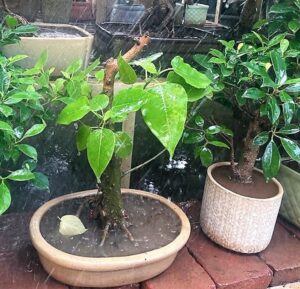 Excessive rainwater can accumulate around the bonsai’s roots, leading to waterlogging. This can suffocate the roots by depriving them of oxygen, resulting in root rot and eventual tree decline.
Excessive rainwater can accumulate around the bonsai’s roots, leading to waterlogging. This can suffocate the roots by depriving them of oxygen, resulting in root rot and eventual tree decline.
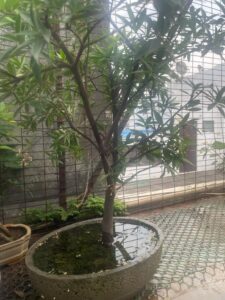 The first and foremost Bonsai care in monsoon season near Delhi for such a problem is to drain out excess water collected in the pot. If you have followed our soil-making recipe, this problem should not pop up during the Rainy Seasons. How to make bonsai soil at Home (2023)will be a great resource to start with making the perfect soil mixture.
The first and foremost Bonsai care in monsoon season near Delhi for such a problem is to drain out excess water collected in the pot. If you have followed our soil-making recipe, this problem should not pop up during the Rainy Seasons. How to make bonsai soil at Home (2023)will be a great resource to start with making the perfect soil mixture.
Root Rot in Bonsais during Monsoon in Delhi:
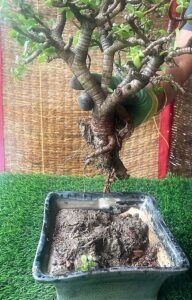 The combination of excessive moisture and poor drainage can cause root rot in bonsai trees. Fungi and bacteria thrive in waterlogged conditions, attacking the roots and causing them to decay. This can weaken the tree and make it more susceptible to other diseases. The second method the bonsai masters suggest for Bonsai care in monsoon season near Delhi is to provide rain shelters over the Bonsai planters or display. This will ensure that bonsais receive only correct amount of rainfall during the monsoon season. Bonsai India: A Complete Guide to Buying and Gifting Trees.
The combination of excessive moisture and poor drainage can cause root rot in bonsai trees. Fungi and bacteria thrive in waterlogged conditions, attacking the roots and causing them to decay. This can weaken the tree and make it more susceptible to other diseases. The second method the bonsai masters suggest for Bonsai care in monsoon season near Delhi is to provide rain shelters over the Bonsai planters or display. This will ensure that bonsais receive only correct amount of rainfall during the monsoon season. Bonsai India: A Complete Guide to Buying and Gifting Trees.
Fungal Diseases in Bonsai Due to high Humidity Levels:
 High humidity during the monsoon season promotes the growth of various fungal diseases, such as powdery mildew and leaf spot. These diseases can affect the foliage and overall health of the bonsai. Fungus gnats and other pests may also become more prevalent.
High humidity during the monsoon season promotes the growth of various fungal diseases, such as powdery mildew and leaf spot. These diseases can affect the foliage and overall health of the bonsai. Fungus gnats and other pests may also become more prevalent.
To mitigate such conditions developing in your rare and beautiful bonsai the technical experts at Delhi Bonsai issue warning and Bonsai care in monsoon season near Delhi newsletters to all the valued customers. Special bonsai care camps are organized, where all our previous customers can bring bonsais for special treatments. The best possible way to mitigate this issue is by spraying Bavistin spray once a fortnight during high-humidity monsoon months.
Nutrient Imbalance in Bonsais:
Excessive rainfall can leach out essential nutrients from the soil, leading to nutrient imbalances. This can negatively impact the tree’s growth, vigour, and overall health. Adjusting the fertilization routine becomes important during this period. To adjust fertilizer levels Apply a pinch of DAP & MOP in all the bonsais.
Overwatering and Underwatering of Bonsai during the rainy season:
Monitoring the moisture levels in the bonsai’s soil with regular rainfall is crucial. Overwatering can cause stress, and root suffocation, and hinder nutrient uptake. It’s important to strike a balance and avoid keeping the soil too wet for prolonged periods. One should always check the soil moisture of bonsai because some of the bonsai may even remain dry due to its placement even in heavy rainfall. The easiest Bonsai care in monsoon season near Delhi for such a problem is to adjust the placement of the Bonsais , so that all the bonsais receive optimum rain during the season.
Erosion and Soil Compaction of Bonsai Soil during Monsoon and Rainy Season:
Heavy rain can wash away the topsoil from the bonsai pot, exposing the roots. This erosion can disrupt the root system and impact the stability of the tree. Additionally, rainwater can compact the soil, reducing its ability to retain oxygen and water. Our Bonsai master’s suggestions on Bonsai care in monsoon season near Delhi for this issue is to add more Dry Bonsai soil to such pots and Tighten the loosened Bonsai Plant.
Pests and Diseases in Bonsais during Monsoon in Delhi NCR Regions:
The increased humidity and moisture provide a favourable environment for pests, such as aphids, mites, slugs, and fungal and bacterial diseases. Regular inspection and prompt treatment are necessary to prevent infestations and keep the bonsai healthy.
In a nutshell, to mitigate these problems, providing proper shelter and drainage for the bonsai trees during heavy rains is important. Ensuring adequate air circulation, maintaining a balanced watering schedule, and adjusting fertilization practices are crucial. Regular monitoring, timely pruning, and appropriate pest and disease control measures can help maintain the health and well-being of the bonsai during the monsoon season.
Shelter: Protect your bonsai trees from heavy rain, as excessive water can damage the delicate roots and cause root rot. Provide a sheltered location, such as a covered patio or balcony, where the trees can still receive indirect light but are shielded from direct rainfall.
Drainage: Ensure proper drainage for your bonsai pots. Excess water should be able to drain freely to prevent waterlogging. Check the drainage holes in the pots and use a well-draining bonsai soil mix to promote good water flow.
Pruning: Regularly inspect your bonsai trees for any weak or diseased branches. Prune them off to maintain the health and aesthetics of the tree. Additionally, remove any dead or yellowing leaves to prevent the spread of diseases. How to Care Your Banyan Bonsai Tree will give you a fair idea for pruning and other care techniques.
Fertilization: Adjust your bonsai fertilization routine during the monsoon. Reduce the frequency of fertilizing to avoid overfeeding the trees, as the increased moisture can make them more susceptible to nutrient imbalances. Use a balanced, slow-release fertilizer to provide essential nutrients gradually.
Pest Control: The monsoon season can bring about increased humidity, which creates a favourable environment for pests and diseases. Monitor your bonsai trees closely for signs of pest infestations such as aphids, mites, or fungal issues. If needed, use appropriate insecticides or fungicides to control the problem.
Air Circulation: Ensure proper air circulation around your bonsai trees. Good air movement helps prevent fungal growth and promotes healthy foliage. Avoid overcrowding the trees and maintain sufficient spacing between them.
Watering: Adjust your watering routine to account for the increased rainfall during the monsoon. Monitor the moisture level of the soil regularly and water only when the top inch of the soil feels slightly dry. Be cautious not to overwater, as this can lead to root rot.
Repotting: Repot bonsai is generally not recommended during the monsoon season. The excess moisture can disrupt the root system’s recovery, making it more vulnerable to stress and diseases. It’s best to wait until the rainy season subsides before considering repotting. The Complete Guide to Ficus Bonsai: From Care to Maintenance, Here we have discussed general bonsai care and a must-read.
Pre and Post Bonsai care in monsoon season near Delhi.
Pre and post-bonsai care during the monsoon season near Delhi involves specific actions to prepare your bonsai trees for the rainy period and to maintain their health afterwards. Here’s a guide on pre and post-monsoon bonsai care:
Pre-Monsoon Bonsai Care:
Pruning: Before the monsoon season begins, perform a thorough pruning of your bonsai trees. Remove any dead or diseased branches, as well as excessive foliage. Pruning helps improve air circulation and reduces the risk of fungal infections.
Repotting: If necessary, consider repotting your bonsai before the onset of monsoons. Repotting allows for root inspection, removal of compacted soil, and renewal of the growing medium. However, it’s best to complete the repotting process well in advance to allow the tree to recover before the heavy rains arrive.
Soil Preparation: Ensure that your bonsai soil has good drainage properties. Use a well-draining soil mix that allows excess water to flow out easily. This helps prevent waterlogging and root rot during the monsoon.
Placement: Find a sheltered location for your bonsai trees, such as a covered patio or balcony, to protect them from heavy rain. Avoid exposing them to direct rainfall, as excessive water can damage the trees.
Pest and Disease Control: Conduct a thorough inspection of your bonsai trees for any signs of pests or diseases. Treat any existing issues before the monsoon season starts to prevent them from worsening during the rainy period.
Post-Monsoon Bonsai Care:
Drainage Check: After the monsoon season, inspect the drainage holes of your bonsai pots. Clear any debris or blockages that may have accumulated during the rains. Ensure that the water can freely drain from the pots to prevent waterlogging.
Pruning and Cleaning: Assess the condition of your bonsai trees post-monsoon and remove any damaged, dead, or weak branches. Clean the tree by gently removing fallen leaves and debris to maintain its aesthetics and prevent the spread of diseases.
Fertilization: After the monsoon, consider resuming a regular fertilization routine. Use a balanced, slow-release fertilizer to provide essential nutrients gradually. This helps replenish any nutrients that may have been leached away by heavy rainfall.
Pest and Disease Control: Monitor your bonsai trees closely for any signs of pests or diseases that may have emerged during the monsoon. Take necessary measures, such as applying insecticides or fungicides, to control and treat any issues promptly.
Sunlight Exposure: As the monsoon season wanes and sunlight becomes more abundant, gradually increase the exposure of your bonsai trees to sunlight. This will help stimulate healthy growth and photosynthesis.
By following these pre and post-monsoon care practices, you can ensure the well-being of your bonsai trees near Delhi. Remember to observe your trees closely, adapt care techniques based on their specific needs, and address any issues promptly to maintain their overall health and vitality.
Featured Plants
India’s Best and Authentic Bonsai Plants Home delivered in 3 Hours.
Our Motto
What you see is what you get
Delivery
Personalised delivery at door step
Mission
Creating green spaces
Must Read
Do we leave Bonsai outside in rains?
Rain Water is a rich source of Nitrogen, which helps bonsais grow. Yes, you can leave bonsais outside in the rain but certain precautions have to be taken, like don't expose them in high-intensity rain, Place bonsais where they can get indirect rain showers.
बारिश होने पर बोन्साई का क्या करें?
बोनसाई विकास के लिए बारिश अच्छी होती है। वर्षा जल पौधों के लिए नाइट्रोजन का अच्छा स्रोत है। यदि बहुत भारी बारिश होती है और कई दिनों तक लगातार बारिश होती है, तो बोनसाई को सुरक्षित स्थान पर रख दें, जहां उन्हें सीधे बारिश न मिले। बरसात के मौसम में जलजमाव पर नजर रखें। बरसात के मौसम में कीट-पतंगों के संक्रमण की संभावना रहती है, इस पर भी सावधानी से नजर रखनी होगी।
